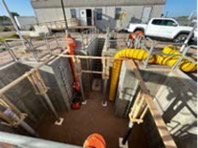ERC's Bio-inspired Deep Foundation Systems Provide Greater Shaft Resistance
Outcome/Accomplishment
The Center for Bio-mediated and Bio-inspired Geotechnics (CBBG), an NSF-funded Engineering Research Center (ERC) headquartered at Arizona State University, has developed bio-inspired deep foundation systems that provide greater shaft resistance than conventional piles of the same dimensions. The design draws from the root systems of plants and other living things.
Impact/Benefits
Shaft resistance is the major source of bearing capacity and it has a critical effect on the settlement of piles that are driven into the ground to support structures. Pile load tests confirmed that the bio-inspired, laterally expansive pile can provide considerably greater load capacity, greatly improving efficiency and sustainability.
Explanation/Background
The bio-inspired deep foundation systems developed by the NSF-funded Center demonstrated an increased mid-scale load bearing capacity of 120% to 170%—and potentially even higher—after installation. Researchers conducted 14 pile load tests on instrumented 6-inch diameter prototypes of expansive piles and control piles in a test pit facility.
The CBBG research team filed for a new patent for bio-inspired radially expansive piles/anchors based on their research, which was awarded in October 2021. New pile shaft expansion mechanisms are also in development.
Location
Tempe, ArizonaStart Year
Energy and Sustainability
Energy, Sustainability, and Infrastructure
Lead Institution
Core Partners
Fact Sheet
Outcome/Accomplishment
The Center for Bio-mediated and Bio-inspired Geotechnics (CBBG), an NSF-funded Engineering Research Center (ERC) headquartered at Arizona State University, has developed bio-inspired deep foundation systems that provide greater shaft resistance than conventional piles of the same dimensions. The design draws from the root systems of plants and other living things.
Location
Tempe, ArizonaStart Year
Energy and Sustainability
Energy, Sustainability, and Infrastructure
Lead Institution
Core Partners
Fact Sheet
Impact/benefits
Shaft resistance is the major source of bearing capacity and it has a critical effect on the settlement of piles that are driven into the ground to support structures. Pile load tests confirmed that the bio-inspired, laterally expansive pile can provide considerably greater load capacity, greatly improving efficiency and sustainability.
Explanation/Background
The bio-inspired deep foundation systems developed by the NSF-funded Center demonstrated an increased mid-scale load bearing capacity of 120% to 170%—and potentially even higher—after installation. Researchers conducted 14 pile load tests on instrumented 6-inch diameter prototypes of expansive piles and control piles in a test pit facility.
The CBBG research team filed for a new patent for bio-inspired radially expansive piles/anchors based on their research, which was awarded in October 2021. New pile shaft expansion mechanisms are also in development.

